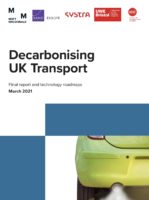 A guest post co-written with Glenn Lyons and Charlene Rohr.
A guest post co-written with Glenn Lyons and Charlene Rohr.
Alongside last week’s publication of the UK Government’s Transport Decarbonisation Plan, one of the supporting documents now available is “Decarbonising UK Transport: Final report and technology roadmaps”. At the request of the Department for Transport, Mott MacDonald and partners (as part of the team’s ongoing ‘futures support’ to the DfT) considered what needs to be achieved over the next three decades, in terms of technological solutions, to reduce and remove direct emissions from the UK’s domestic transport sector across modes by 2050.
The remit was to address ‘tailpipe’ emissions from vehicles when in use, as opposed to the wider need to also tackle such emissions through travel behaviour change (such as travelling less or switching to more efficient and less carbon intensive means of travel). While the UK Government has now confirmed that international aviation and shipping will come into the scope of its carbon budgets from 2033, this work was asked to focus on domestic transport within the UK.
Technology roadmaps
The report sets out technology roadmaps for cars and light goods vehicles; buses; coaches; heavy goods vehicles; rail; domestic shipping; and domestic aviation. Each detailed roadmap considers the progression of relevant candidate technology solutions. The roadmaps work backwards from an achievable 2050 end state (aligned to the goal of decarbonisation), identifying developments and milestones over the period between 2050 and 2020 that would enable the 2050 end state to be reached.
Developments consider fleet turnover (the replacement of CO2-emitting vehicles with zero-emission vehicles) and the supporting infrastructure (for refuelling/recharging those zero emission vehicles). Underpinning the developments, the roadmaps set out recommended research and innovation interventions that need to be progressed in the coming five to ten years.
Ten takeaways
Do have a look at the report, which is intended to provide a ‘big picture’ view of the transport sector’s decarbonisation agenda in terms of technological solutions. Here are ten take-away points:
1. It is possible to decarbonise road travel by 2050, but decarbonising domestic shipping and aviation will be more challenging.
Full removal of direct emissions can be achieved by 2050 for cars, light goods vehicles and buses; full or near full removal can be achieved for coaches and heavy goods vehicles; near full removal can be achieved for trains; significant removal is achievable for domestic shipping; and partial removal of direct emissions is achievable for domestic aviation.
2. Battery technology is a key part of the decarbonisation story.
Battery technology is a key solution for the removal of tailpipe emissions (especially for road transport) and is further ahead of other technologies such as hydrogen propulsion in terms of market readiness and adoption. But further research and innovation is required to increase battery density to increase vehicle driving range. More and better charging facilities are also urgently needed. In the medium to longer term, recycling facilities need to be developed to ensure sustainable use of precious metals in batteries. However, there are risks in relying on battery technology to the exclusion of other solutions. Global supply of precious metals used in the manufacture of batteries may or may not become a challenge in future as batteries need replacing and fleet turnover towards battery-electric propulsion accelerates internationally. We therefore need other solutions to be in play (Plan B). It goes without saying that it is essential that our electricity supply is fully decarbonised to support net zero more broadly.
Green hydrogen
3. Green hydrogen could be integral to achieving full decarbonisation.
While hydrogen may not be a primary decarbonisation solution to direct emissions for any one mode, it could have significant benefits for specific hard-to-decarbonise modal use cases. Moreover, the importance of hydrogen could increase if: (i) other solutions fail to fully deliver (hydrogen as Plan B); and/or (ii) the wider economy’s dependence on hydrogen leads to scaling up of availability and falling prices. At the same time, from a whole economy perspective, hydrogen production must be net-zero in terms of CO2.
4. Fleet turnover is an important factor in the pace for decarbonisation.
Decarbonising travel, particularly road travel, largely involves replacing vehicles that produce emissions with those that do not. This relies upon technological advancements and breakthroughs, it relies upon manufacturers to take advantage of such developments in their product lines, and it relies upon consumer or business demand for the vehicles. The rate of change is also dependent upon the service life of a vehicle and this can vary from a few years for intensively used heavy goods vehicles to decades for rail locomotives.**
5. There is a pressing need for infrastructure development.
Dominant across the set of roadmaps is the need for the associated infrastructure requirements to be better understood and developed. In some cases, for example for cars and light goods vehicles, it is clear that battery electric vehicles are a key part of the solution and therefore the focus needs to be on understanding consumer needs for charging and rolling out solutions to support take-up of battery electric vehicles. In other cases, such as for heavy goods vehicles, the solutions are less clear, requiring research to better understand the solutions, to identify priority solutions and to provide the required infrastructure, across the country.
Starting now
6. Decarbonisation of transport needs to start immediately.
There is lots to do across all modes of travel. Research and innovation are precursors to market readiness and scaling. They are therefore a priority for the earlier part of the 30-year period ahead across all the roadmaps. Most notably, for road-based transport, the recommended research and innovation interventions need to start within the next five years – or better have been completed – by then. These include highly challenging trials – spanning different forms of solutions – for infrastructure development and use that in turn must inform forward developments in infrastructure roll-out.
7. There is a need for co-operation.
Government is focused upon outcome requirements and keen to see the private sector take a lead in determining the most appropriate solutions to bring to market. Meanwhile the private sector needs the Government to offer direction and enough certainty so it can make reliable decisions about investment. With an urgent need for concurrent fleet turnover and infrastructure development, co-operation is crucial on both sides.
8. There is substantial uncertainty.
Decarbonisation by 2050 is not an aspiration or stretch target. It is a goal that must be achieved. There is substantial uncertainty in how different technologies will evolve and which will be most successful over the medium to long term. It is therefore important to ensure that we explore and keep open several promising options, alongside encouraging complementary interventions, notably behaviour change to reduce travel or encourage switching to more efficient and less carbon intensive means of travel.
9. There is a need to monitor and adapt.
The roadmaps are designed to offer some flexibility of pathways that can be taken according to how developments proceed in the face of uncertainty. Nevertheless, the roadmaps themselves must be kept under review and adapted as appropriate over time in line with monitoring of progress and accommodation of new requirements – such as the incorporation of international aviation and shipping.
10. The importance of systems thinking.
Reduction and removal of direct emissions from across all modes cannot be addressed by considering individual modes in isolation. There are inter-dependencies and spill-over benefits in relation to both vehicle technology advances and infrastructure provision (and upstream energy production, storage and distribution). A whole system view is critical—and this report offers an important contribution to this.
“Decarbonising UK Transport: Final report and technology roadmaps” is an independent report by Mott MacDonald and its partners: RAND Europe, SYSTRA, the University of the West of England and the School of International Futures, authored by Glenn Lyons, Andrew Curry and Charlene Rohr.





